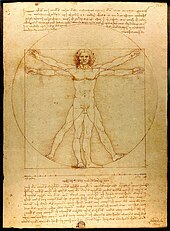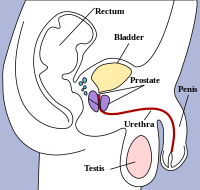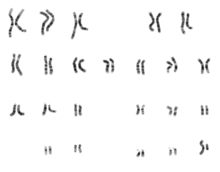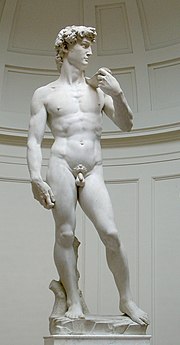| Revision as of 07:18, 27 June 2019 view sourceSunCrow (talk | contribs)Extended confirmed users25,809 edits reorganize← Previous edit | Revision as of 14:23, 1 July 2019 view source WanderingWanda (talk | contribs)Extended confirmed users, Rollbackers5,229 edits Restoring longstanding version of lead per WP:BRDNext edit → | ||
| Line 7: | Line 7: | ||
| ]<!--PLEASE NOTE: This image was selected following extensive discussion at https://en.wikipedia.org/Talk:Man/sandbox, along with additional discussion on this article's talk page. Please do not remove or replace without talk page consensus. Thank you.--> | ]<!--PLEASE NOTE: This image was selected following extensive discussion at https://en.wikipedia.org/Talk:Man/sandbox, along with additional discussion on this article's talk page. Please do not remove or replace without talk page consensus. Thank you.--> | ||
| {{Masculinism sidebar}} | {{Masculinism sidebar}} | ||
| A '''man''' is a ] human.<!--The word adult is not needed in this sentence; see the following sentence.--> The term ''man'' is reserved for an ] male, with the term '']'' being the usual term for a male child or adolescent. | A '''man''' is a ] human.<!--The word adult is not needed in this sentence; see the following sentence.--> The term ''man'' is usually reserved for an ] male, with the term '']'' being the usual term for a male child or adolescent. However, the term ''man'' is also sometimes used to identify a male human, regardless of age, as in phrases such as "]". | ||
| Like most other male ]s, a man's ] typically inherits an ] from his mother and a ] from his father. The male ] produces larger amounts of ]s and smaller amounts of ]s than a female fetus. This difference in the relative amounts of these ]s is largely responsible for the ] differences that distinguish men from women. During puberty, hormones which stimulate androgen production result in the development of ]s, thus exhibiting greater differences between the sexes. However, there are exceptions to the above for some ] and ] men. | |||
| ==Etymology== | ==Etymology== | ||
Revision as of 14:23, 1 July 2019
| This article needs additional citations for verification. Please help improve this article by adding citations to reliable sources. Unsourced material may be challenged and removed. Find sources: "Man" – news · newspapers · books · scholar · JSTOR (June 2019) (Learn how and when to remove this message) |

| Part of a series on | ||||
| Masculism | ||||
|---|---|---|---|---|
 | ||||
|
Movements |
||||
Topics and issues
|
||||
By country
|
||||
|
Lists and categories |
||||
|
See also |
||||
A man is a male human. The term man is usually reserved for an adult male, with the term boy being the usual term for a male child or adolescent. However, the term man is also sometimes used to identify a male human, regardless of age, as in phrases such as "men's basketball".
Like most other male mammals, a man's genome typically inherits an X chromosome from his mother and a Y chromosome from his father. The male fetus produces larger amounts of androgens and smaller amounts of estrogens than a female fetus. This difference in the relative amounts of these sex steroids is largely responsible for the physiological differences that distinguish men from women. During puberty, hormones which stimulate androgen production result in the development of secondary sexual characteristics, thus exhibiting greater differences between the sexes. However, there are exceptions to the above for some transgender and intersex men.
Etymology
Main article: Man (word)The English term "man" is derived from a Proto-Indo-European root *man- (see Sanskrit/Avestan manu-, Slavic mǫž "man, male"). More directly, the word derives from Old English mann. The Old English form had a default meaning of "adult male" (which was the exclusive meaning of wer), though it could also signify a person of unspecified gender. The closely related Old English pronoun man was used just as it is in Modern German to designate "one" (e. g., in the saying man muss mit den Wölfen heulen). The Old English form is derived from Proto-Germanic *mannz, "human being, person", which is also the etymon of German Mann "man, husband" and man "one" (pronoun), Old Norse maðr, and Gothic manna. According to Tacitus, the mythological progenitor of the Germanic tribes was called Mannus. Manus in Indo-European mythology was the first man (see Mannus, Manu (Hinduism)).
Terminology
Main article: VirilityThe term manhood is used to describe the adult period in a human male's life. A man reaches manhood after he has passed through puberty and has generally attained male secondary sexual characteristics. The word man is used to mean any adult male. In English-speaking countries, many other words can also be used to mean an adult male such as guy, dude, buddy, bloke, fellow, chap and sometimes boy or lad. The term manhood is associated with masculinity and virility, which refer to male qualities and male gender roles.
Biology
Main articles: Secondary sexual characteristics and Sex differences in humans See also: Trans man and IntersexualityHumans exhibit sexual dimorphism in many characteristics, many of which have no direct link to reproductive ability, although most of these characteristics do have a role in sexual attraction. Most expressions of sexual dimorphism in humans are found in height, weight, and body structure, though there are always examples that do not follow the overall pattern. For example, men tend to be taller than women, but there are many people of both sexes who are in the mid-height range for the species.

Examples of typical human male secondary sexual characteristics include:
- Pubic hair;
- Facial hair;
- Larger hands and feet than women;
- Broader shoulders and chests than women;
- Larger skull and bone structure than women;
- Larger brain mass and volume than women;
- Greater muscle mass than women;
- A more prominent Adam's apple and deeper voice than women;
- Greater height than women; and
- A higher tibia-to-femur ratio than women.

Sexual characteristics
In mankind, the sex of an individual is determined at the time of fertilization by the genetic material carried in the sperm cell. If a sperm cell carrying an X chromosome fertilizes the egg, the offspring will typically be female (XX). On the other hand, if a sperm cell carrying a Y chromosome fertilizes the egg, the offspring will typically be male (XY). Persons whose anatomy or chromosomal makeup differ from this pattern are referred to as intersex.
Like most other male mammals, a man's genome typically inherits an X chromosome from his mother and a Y chromosome from his father. The male fetus produces larger amounts of androgens and smaller amounts of estrogens than a female fetus. This difference in the relative amounts of these sex steroids is largely responsible for the physiological differences that distinguish men from women.
The term primary sexual characteristics denotes the kind of gamete the gonad produces. The ovary produces egg cells in the female, and the testis produces sperm cells in the male. The term secondary sexual characteristics denotes all other sexual distinctions that play indirect roles in uniting sperm and eggs. Secondary sexual characteristics include everything from the specialized male and female features of the genital tract to the brilliant plumage of male birds or facial hair of humans.
Biological factors are not always sufficient determinants of whether a person considers themselves a man or is considered a man. Intersex individuals, who have physical or genetic features considered to be mixed or atypical for one sex or the other, may use other criteria in making a clear determination.
Reproductive system
Main article: Male reproductive system (human)
The male sex organs are part of a man's reproductive system, consisting of the penis, testicles, vas deferens, and the prostate gland. The male reproductive system's function is to produce semen, which carries sperm and thus genetic information that can unite with an egg within a woman. Since sperm that enters a woman's uterus and then fallopian tubes goes on to fertilize an egg which develops into a fetus or child, the male reproductive system plays no necessary role during the gestation. The study of male reproduction and associated organs is called andrology.

Sex hormones
In mammals, the hormones that influence sexual differentiation and development are androgens (mainly testosterone), which stimulate later development of the ovary. In the sexually undifferentiated embryo, testosterone stimulates the development of the Wolffian ducts, the penis, and closure of the labioscrotal folds into the scrotum. Another significant hormone in sexual differentiation is the anti-Müllerian hormone, which inhibits development of the Müllerian ducts. For males during puberty, testosterone, along with gonadotropins released by the pituitary gland, stimulates spermatogenesis.
Illnesses
In general, men suffer from many of the same illnesses as women. In comparison to women, men suffer from slightly more illnesses. Male life expectancy is slightly lower than female life expectancy.
Masculinity
Main article: Masculinity See also: Stereotype
Masculinity is a set of attributes, behaviors, and roles associated with boys and men. As a social construct, it is distinct from the definition of the male biological sex. This means that masculinity is less concerned with the physical facts of people's bodies and more concerned with how people live. For example, do these people embody the personal values that their own cultures associate with manliness? Do these people engage in activities that their own cultures deem appropriate for men?
Standards of manliness or masculinity vary across different cultures and historical periods. While the outward signs of masculinity look different in different cultures, there are some common aspects to its definition across cultures. In all cultures in the past, and still among traditional and non-Western cultures, getting married is the most common and definitive distinction between boyhood and manhood. Some qualities traditionally associated with marriage, such as the "triple Ps" of protecting, providing, and procreating, are still considered signs of having achieved manhood.
Gender scholars use the phrase "hegemonic masculinity" to distinguish the most dominant form of masculinity from other variants. In the mid-twentieth century United States, for example, John Wayne might embody one form of masculinity, while Albert Einstein might be seen as masculine, but not in the same "hegemonic" fashion.
Anthropology has shown that masculinity itself has social status, just like wealth, race and social class. In western culture, for example, greater masculinity usually brings greater social status. Many English words such as virtue and virile (from the Indo-European root vir meaning man) reflect this. An association with physical or moral strength is implied. Masculinity is associated more commonly with adult men than with boys.
In many cultures displaying characteristics not typical to one's gender may become a social problem for the individual. Among men, the exhibition of feminine behavior may be considered a sign of homosexuality, while the same is for a woman who exhibits masculine behavior. Within sociology such labeling and conditioning is known as gender assumptions and is a part of socialization to better match a culture's mores.
The relative importance of the roles of socialization and genetics in the development of masculinity continues to be debated. While social conditioning obviously plays a role, it can also be observed that certain aspects of the masculine identity exist in almost all human cultures.
The historical development of gender role is addressed by such fields as behavioral genetics, evolutionary psychology, human ecology and sociobiology. All human cultures seem to encourage the development of gender roles, through literature, costume and song. Some examples of this might include the epics of Homer, the King Arthur tales in English, the normative commentaries of Confucius or biographical studies of Muhammad. More specialized treatments of masculinity may be found in works such as the Bhagavad Gita or bushido's Hagakure.
Culture and gender roles
Main article: Gender role
Well into prehistoric culture, men are believed to have assumed a variety of social and cultural roles which are likely similar across many groups of humans. In hunter-gatherer societies, men were often if not exclusively responsible for all large game killed, the capture and raising of most or all domesticated animals, the building of permanent shelters, the defense of villages, and other tasks where the male physique and strong spatial-cognition were most useful. Some anthropologists believe that it may have been men who led the Neolithic Revolution and became the first pre-historical ranchers, as a possible result of their intimate knowledge of animal life.
Throughout history, the roles of men have changed greatly. As societies have moved away from agriculture as a primary source of jobs, the emphasis on male physical ability has waned. Traditional gender roles for working men typically involved jobs emphasizing moderate to hard manual labor (see Blue-collar worker), often with no hope for increase in wage or position. For poorer men among the working classes, the need to support their families, especially during periods of industrial change and economic decline, forced them to stay in dangerous jobs working long arduous hours, often without retirement. Many industrialized countries have seen a shift to jobs which are less physically demanding, with a general reduction in the percentage of manual labor needed in the work force (see White-collar worker). The male goal in these circumstances is often of pursuing a quality education and securing a dependable, often office-environment, source of income.

The Men's Movement is in part a struggle for the recognition of equality of opportunity with women, and for equal rights irrespective of gender, even if special relations and conditions are willingly incurred under the form of partnership involved in marriage. The difficulties of obtaining this recognition are due to the habits and customs recent history has produced. Through a combination of economic changes and the efforts of the feminist movement in recent decades, men in some societies now compete with women for jobs that traditionally excluded women. Some larger corporations have instituted tracking systems to try to ensure that jobs are filled based on merit and not just on traditional gender selection. Assumptions and expectations based on sex roles both benefit and harm men in Western society (as they do women, but in different ways) in the workplace as well as on the topics of education, violence, health care, politics, and fatherhood – to name a few. Research has identified anti-male sexism in some areas which can result in what appear to be unfair advantages given to women.
The Parsons model was used to contrast and illustrate extreme positions on gender roles. Model A describes total separation of male and female roles, while Model B describes the complete dissolution of barriers between gender roles. The examples are based on the context of the culture and infrastructure of the United States. However, these extreme positions are rarely found in reality; actual behavior of individuals is usually somewhere between these poles. The most common 'model' followed in real life in the United States and Great Britain is the 'model of double burden'.
Exclusively male roles
Some positions and titles are reserved for men only. For example, the position of Pope and Bishop in the Roman Catholic Church. Also the priesthood is exclusively male in the Catholic Church and also some other religious traditions. Men are often given priority for the position of monarch (King in the case of a man) of a country, as it usually passes to the eldest male child upon succession.
See also
Medical:
Dynamics:
Political:
References
- American Heritage Dictionary, Appendix I: Indo-European Roots. man-1 Archived 19 May 2006 at the Wayback Machine. Accessed 2007-07-22.
- John Richard Clark Hall: A Concise Anglo-Saxon Dictionary
- The Vitruvian man
- Ferrante, Joan (2008), "Gender and sexualities: with emphasis on gender ideals", in Ferrante, Joan, ed. (1 January 2010). Sociology: a global perspective (7th ed.). Belmont, California: Thomson Wadsworth. pp. 269–272. ISBN 9780840032041.
- "Gender, Women and Health: What do we mean by "sex" and "gender"?". who.int. World Health Organization. Archived from the original on 8 September 2014. Retrieved 17 September 2014.
- Kimmel, Michael S.; Aronson, Amy, eds. (2004). Men and Masculinities: A Social, Cultural, and Historical Encyclopedia, Volume 1. Santa Barbara, Calif.: ABC-CLIO. p. xxiii. ISBN 978-1-57-607774-0.
- ^ Arnett, Jeffrey Jensen (1998). "Learning to Stand Alone: The Contemporary American Transition to Adulthood in Cultural and Historical Context". Human Development. 41 (5–6): 295–315. doi:10.1159/000022591. ISSN 0018-716X.
- Gilmore, David D. (1990). Manhood in the Making: Cultural Concepts of Masculinity. Yale University Press. p. 48. ISBN 0-300-05076-3.
- "Virtue (2009)". Merriam-Webster Online Dictionary. 2009. Retrieved 8 June 2009.
{{cite web}}: Cite has empty unknown parameter:|month=(help) - "Virile (2009)". Merriam-Webster Online Dictionary. 2009. Retrieved 8 June 2009.
{{cite web}}: Cite has empty unknown parameter:|month=(help) - Brockhaus: Enzyklopädie der Psychologie, 2001.
Further reading
- Andrew Perchuk, Simon Watney, bell hooks, The Masculine Masquerade: Masculinity and Representation, MIT Press 1995
- Pierre Bourdieu, Masculine Domination, Paperback Edition, Stanford University Press 2001
- Robert W. Connell, Masculinities, Cambridge : Polity Press, 1995
- Warren Farrell, The Myth of Male Power Berkley Trade, 1993 ISBN 0-425-18144-8
- Michael Kimmel (ed.), Robert W. Connell (ed.), Jeff Hearn (ed.), Handbook of Studies on Men and Masculinities, Sage Publications 2004
External links
 The dictionary definition of man at Wiktionary
The dictionary definition of man at Wiktionary Quotations related to Man at Wikiquote
Quotations related to Man at Wikiquote Media related to Men at Wikimedia Commons
Media related to Men at Wikimedia Commons
| Gender and sexual identities | |||||||||
|---|---|---|---|---|---|---|---|---|---|
| Gender identities | |||||||||
| Sexual orientation identities |
| ||||||||
| See also | |||||||||
| Masculism | |||||||||||
|---|---|---|---|---|---|---|---|---|---|---|---|
| Concepts |
| ||||||||||
| Movements |
| ||||||||||
| People | |||||||||||
| Remembrance days |
| ||||||||||
| Issues |
| ||||||||||
Categories: